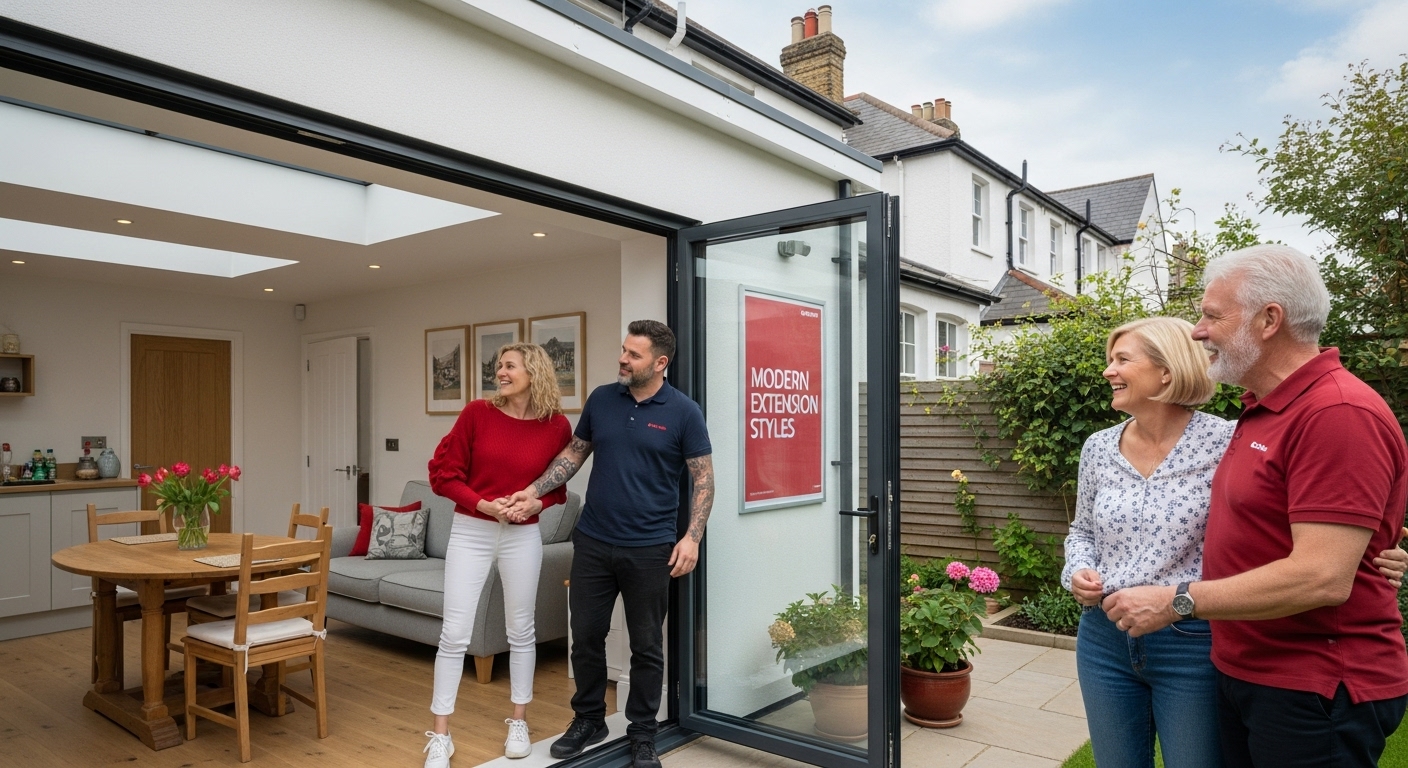Many people dream of having a more spacious and comfortable home, and home extensions have become the answer for thousands across the UK. You might assume most home improvements drain your savings without adding real value, but that is not always true. A well-designed extension can increase your property’s market worth by up to 25 percent, making it both a practical and surprisingly profitable investment.
Table of Contents
- What Are Home Extensions And Their Key Benefits?
- Why Choose Different Types Of Home Extensions?
- How Do Home Extensions Impact Property Value?
- Examining Popular Types Of Home Extensions
Quick Summary
| Takeaway | Explanation |
|---|---|
| Home extensions boost property value significantly. | Well-designed extensions can enhance property worth by 10-25%, reflecting strategic investment. |
| Choose extension types based on specific needs. | Understand your space requirements, budget, and desired functionality to select the ideal extension type. |
| Extensions should align with local regulations. | Compliance with planning laws is essential for the success and legality of home extensions. |
| Thoughtful design improves functionality. | A well-integrated extension creates harmonious living spaces that cater to modern lifestyle demands. |
| Consider market expectations when extending. | Research local real estate trends to ensure your extension meets or exceeds market demands for maximum appreciation. |
What Are Home Extensions and Their Key Benefits?
Home extensions represent strategic property transformations that enable homeowners to expand and enhance their living spaces without relocating. These architectural solutions provide flexible opportunities to reimagine residential environments, addressing contemporary lifestyle needs while maximising existing property potential.
Understanding Home Extension Fundamentals
A home extension is a structural modification that physically increases the usable floor area of an existing residential property. Structural modifications can range from modest rear kitchen expansions to comprehensive two-storey additions that dramatically reshape a home’s footprint and functionality.
Key characteristics of successful home extensions include:
- Seamless integration with existing architectural design
- Compliance with local planning regulations
- Enhanced property functionality and living experience
- Potential increase in property market value
The Strategic Benefits of Home Extensions
Homeowners pursue extensions for multiple compelling reasons. Property value enhancement represents a primary motivator, with well-designed extensions potentially increasing residential market worth by 10-20%. Moreover, extensions offer a more cost-effective alternative to purchasing a larger property, allowing families to adapt their current home to evolving spatial requirements.
Personal lifestyle improvements constitute another significant advantage. Extensions enable homeowners to create specialised spaces tailored to specific needs, such as home offices, expanded kitchen areas, additional bedrooms, or multifunctional living zones. Read more about lifestyle considerations in our home ideas guide.
Ultimately, home extensions represent an intelligent property investment strategy, combining practical spatial expansion with potential financial appreciation. By thoughtfully designing and executing an extension, homeowners can transform their living environments while making a strategic long-term investment in their property’s future.
Why Choose Different Types of Home Extensions?
Selecting the appropriate home extension type requires careful consideration of multiple factors including property layout, family requirements, budget constraints, and long-term property goals. Understanding the nuanced differences between extension categories enables homeowners to make informed decisions that maximise both functional utility and property value.
Matching Extension Types to Specific Needs
Each extension type offers distinct advantages tailored to specific residential scenarios.
VIDEO:video_content] [Research from architectural planning experts indicates that strategic extension selection can dramatically improve living spaces and property functionality.
Key considerations when choosing an extension include:
- Available outdoor space
- Existing property structural characteristics
- Budget limitations
- Desired additional living area functionality
- Local planning permission requirements
Understanding Extension Motivations
Family Dynamics represent a primary driver for extension selection. Growing families might prioritise additional bedroom space, while professionals could require dedicated home office areas. Some homeowners seek open-plan kitchen extensions to create communal gathering zones, reflecting contemporary lifestyle preferences.
Financial considerations also play a crucial role. Property value appreciation depends significantly on selecting an extension that complements existing architectural design and meets local market expectations. Our comprehensive guide on extension design offers deeper insights into making strategic property improvement choices.
Ultimately, successful home extensions demand a holistic approach. Homeowners must balance personal lifestyle requirements with practical architectural constraints, ensuring their chosen extension type delivers both immediate functional benefits and long-term property investment potential.
How Do Home Extensions Impact Property Value?
Home extensions represent more than mere structural modifications they are strategic investments that can significantly influence residential market value. Understanding the intricate relationship between property improvements and financial appreciation requires a nuanced exploration of multiple economic and architectural factors.
Quantifying Value Enhancement Potential
Research from property valuation experts suggests that well-executed home extensions can increase property worth by 10-25%, depending on design quality, location, and market conditions. Strategic extensions transform living spaces while simultaneously boosting financial potential.
Key value-driving characteristics include:
This table summarises the key value-driving characteristics for home extensions, highlighting the main factors contributing to increased property value as discussed in the article.
| Value-Driving Characteristic | Impact on Property Value |
|---|---|
| Proportional size increase | Larger extension typically yields greater value uplift |
| Quality of architectural integration | Seamless blend with existing structure maximises appeal |
| Functional and modern design | Attracts buyers seeking updated spaces |
| Planning regulation compliance | Avoids legal complications, ensures future resaleability |
| Premium materials | Enhances perceived quality and durability |
- Proportional size increase relative to existing property
- High-quality architectural integration
- Functional and modern design elements
- Compliance with local planning regulations
- Use of premium construction materials
Economic Considerations in Extension Planning
Property value enhancement depends on selecting extensions that align with local market expectations. Different geographical areas demonstrate varied preferences professional-grade home offices might prove more valuable in urban centres, while additional living spaces could be more attractive in suburban environments.
Learn more about smart investment strategies for home extensions that balance immediate lifestyle improvements with long-term financial objectives. Professional valuers consistently emphasise that thoughtful extensions delivering practical functionality typically generate superior return on investment.
Ultimately, successful property value enhancement through extensions requires a holistic approach. Homeowners must balance aesthetic improvements, functional upgrades, and market-aligned design principles to create spaces that not only meet personal needs but also represent intelligent financial investments in their property’s future.
Examining Popular Types of Home Extensions
Home extensions represent diverse architectural solutions that cater to varied residential requirements. Understanding the spectrum of available extension types enables homeowners to make informed decisions about transforming their living spaces strategically and efficiently.
Core Extension Categories
Architectural planning research identifies several fundamental extension types that address different spatial and functional needs. Each extension category offers unique advantages tailored to specific property characteristics and homeowner objectives.
Primary extension types include:
Below is a comparison table outlining the main types of home extensions referred to in the article, helping you easily differentiate their typical purposes and ideal uses.
| Extension Type | Description | Typical Purpose |
|---|---|---|
| Rear Extension | Adds space to the back of the property | Expanding kitchens or living areas |
| Side Return Extension | Builds out into the narrow space at the side | Creating efficient extra living space |
| Wraparound Extension | Combines rear and side extensions | Maximising total ground floor area |
| Single-Storey Extension | Adds a single level to part of the home | Enhancing ground floor functionality |
| Double-Storey Extension | Extends across two storeys | Significant space increase on both levels |
| Loft Conversion | Converts attic into usable space | Adding bedrooms or offices |
| Basement Conversion | Converts basement for additional rooms | Creating extra living or utility rooms |
![]()
- Rear extensions
- Side return extensions
- Wraparound extensions
- Single and double-storey extensions
- Loft and basement conversions
Understanding Extension Design Dynamics
Successful extensions demand meticulous consideration of architectural compatibility, structural integrity, and aesthetic coherence. Rear extensions typically provide straightforward additional ground floor space, ideal for expanding kitchen or living areas. Side return extensions exploit often underutilised narrow spaces alongside properties, creating efficient spatial improvements.
Explore contemporary extension design approaches that blend functional requirements with innovative architectural solutions. Wraparound extensions offer comprehensive property transformation, combining rear and side extension principles to maximise available space and create seamless interior layouts.

Ultimately, selecting the most appropriate extension type requires balancing personal lifestyle needs, property constraints, and long-term investment potential. Homeowners must carefully evaluate their specific requirements to determine the most suitable extension strategy for their unique residential environment.
Ready to Transform Your Home With the Right Extension?
Identifying the best extension for your home is often overwhelming. Perhaps you are unsure whether a rear, side, or wraparound extension suits your needs, or you are worried about balancing design, planning rules, and budget. Many homeowners feel uncertain about how to maximise space and value while making the right decision for their property and their family’s future. That is why gaining a deeper understanding of each extension type is so important, as highlighted in our article. If you want further details on real-life solutions, explore our dedicated page on Types of Home Extensions & Ideas for expert guidance tailored to different requirements and solutions that work in London and Surrey.
Let our team at Reltic Extend turn your vision into a practical and beautiful reality. With over 20 years of experience, we deliver transparent pricing, manage planning permissions, and ensure every home extension is finished on time and on budget. If you are ready to take the next step or want to discuss your ideas with a specialist, get in touch with us directly today. Don’t wait for the perfect home space—make it happen now with the expertise and support of Reltic Extend.
Frequently Asked Questions
What are the different types of home extensions?
Home extensions primarily include rear extensions, side return extensions, wraparound extensions, single and double-storey extensions, and loft or basement conversions. Each type caters to specific needs and property characteristics.
How do I choose the right type of home extension for my property?
Choosing the right extension type involves considering factors like available outdoor space, existing property structure, budget, and the intended functionality of the additional space. It’s crucial to assess how each option aligns with your lifestyle needs and property goals.
What are the benefits of a home extension compared to moving to a larger property?
Home extensions often offer a cost-effective solution for gaining additional space while enhancing property value. They allow homeowners to adapt their current living arrangements to better suit their evolving needs without the hassle of relocating.
How can a home extension increase my property value?
A well-executed home extension can potentially raise property value by 10-25%, depending on design quality, integration with existing architecture, and compliance with local planning regulations. Thoughtful design and functionality improvements are key to maximizing financial returns.





